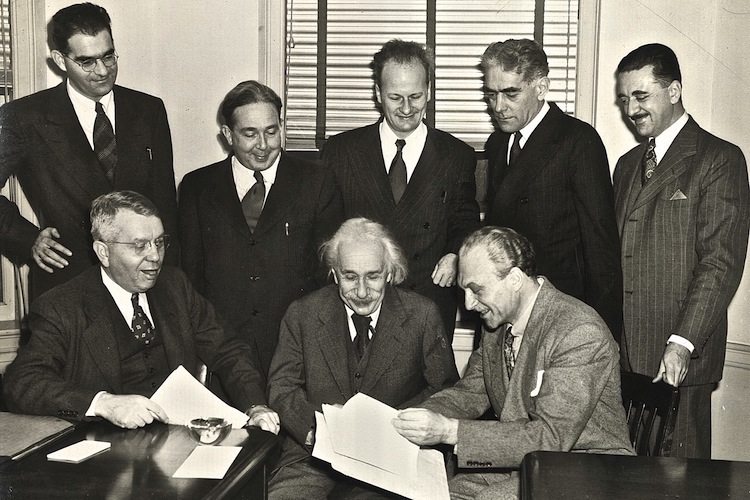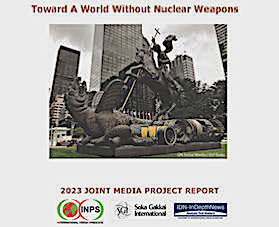By Andrew Lichterman*
OAKLAND, California (IDN) — Seventy-seven years ago, the United Nations General Assembly passed its first resolution. The subject the governments represented there thought important enough to be first on their agenda was the establishment of a commission to develop proposals for the control of atomic energy and “for the elimination from national armaments of atomic weapons and of all other major weapons adaptable to mass destruction.” [2023-01-26]
In a joint statement proposing the Commission, the three governments that had participated in the development of the atomic bomb, the United States, Great Britain, and Canada, stressed that the tasks of controlling atomic energy and eliminating the threat of nuclear weapons and other weapons of mass destruction could not be achieved by monitoring and control measures alone.
“No system of safeguards that can be devised,” they wrote, “will of itself provide an effective guarantee against the production of atomic weapons by a nation bent on aggression.” To end the threat posed by rapidly developing technologies that could yield ever more destructive weapons, they emphasized that a far more ambitious goal must be sought:
“Faced with the terrible realities of the application of science to destruction, every nation will realize more urgently than before the overwhelming need to maintain the rule of law among nations and to banish the scourge of war from the earth.”
A number of the most trenchant commentators of the early atomic age argued that the inquiry must go deeper, focusing not only on the horrific effects but on the causes of modern war. In 1946, journalist and disarmament advocate Norman Cousins wrote,
“Let us have a National Concentration Week, during which we can ponder not only the implications of Hiroshima and Nagasaki, moral and political but the problem of competitive national sovereignty in an atomic age.”
A year later, the Emergency Committee of Atomic Scientists, which included Albert Einstein and several of the physicists who had participated in developing the atomic bomb, warned that
“Through the release of atomic energy, our generation has brought into the world the most revolutionary force since prehistoric man's discovery of fire. This basic power of the universe cannot be fitted into the outmoded concept of narrow nationalisms.”
These insights were clear to many in the immediate aftermath of a catastrophe brought on by competing nationalisms. World War II was a global conflagration of industrialized warfare and genocidal extermination, with the atomic bombings of Hiroshima and Nagasaki only being the culmination.
The United Nations and the broader system of international organizations constructed at the close of World War II was crafted to bring competing nationalisms under control and also to manage the economic forces that had played a central role in driving the underlying conflicts that had led to war.
With the rapid onset of the Cold War in the late 1940s, the focus on the dangers posed by nationalisms in the atomic age faded into the background. The Cold War brought a different kind of competition, a global confrontation between competing political and economic systems with different dynamics and potential flashpoints.
The collapse of the Soviet Union brought both the Cold War political confrontation and the Cold War arms race to a stunning close. With the Cold War confrontation seen as the reason for the existence of vast nuclear arsenals and the risk of nuclear war, mass movements for nuclear disarmament disappeared.
And in the first two decades after the fall of the Berlin Wall, the dangers of competitive nationalisms leading to conflict among nuclear-armed states foreseen by Cousins and the atomic scientists were not immediately apparent. One of the two most powerful states had collapsed and was significantly diminished geographically, economically, and militarily.
China’s emergence as a first-rank economic power still lay in the future. The other leading states were preoccupied with the project of integrating much of the Eurasian continent into the global neoliberal circuit of trade and investment.
And yet, despite these decades of momentous change, nuclear arsenals and the institutions that sustain them carried on, largely without sustained debate by the government or publics. Although their magnitude was reduced in comparison to immense Cold War stockpiles, enough nuclear weapons remain to inflict irreparable harm on humanity and the ecosystems that sustain us.
At the same time, the threat of militant nationalism was slowly growing once more to the point where all of the world’s nuclear-armed countries have authoritarian nationalist parties in power or exercising significant influence in their politics.
Today we find ourselves confronted once more by the extreme danger that many believed had been safely consigned to the past: war driven by identity-based nationalism and involving the world’s most powerful states. And this time around, as prophetic voices warned at the dawn of the nuclear age, the aggressor is nuclear armed.
In a world bristling with high-tech weapons of all kinds, nuclear weapons are unlikely to be eliminated until the forces driving military competition among nuclear-armed countries are eliminated. Meaningful progress towards disarmament will require social movements broad and deep enough to address the causes of high-tech militarism and war.
Movements of this kind also will be needed to stave off catastrophic wars in the near term. These movements will need to bring together work for peace and disarmament with the disparate strands of work against environmental breakdown, polarization of wealth and economic injustice, erosion of democracy, and the targeting of migrants, national minorities, and other vulnerable people.
The connections between these issues will have to be understood at the level of their common causes in a global economy whose central dynamic for centuries has been endless material growth driven by ruthless competition among authoritarian organizations of ever-increasing size and power.
To avoid catastrophe, we will need new movements and politics broad and deep enough to transform our economy, our technology, and how we conceive “the state” and its purposes. Nuclear disarmament will come only through the vehicle of such movements, such as politics. This same path also is our best hope for reducing the risk of war.
*Andrew Lichterman is a policy analyst and lawyer with the Oakland, California-based Western States Legal Foundation. [IDN-InDepthNews – 26 January 2023]
Photo: Members of the Emergency Committee of Atomic Scientists in Princeton, New Jersey, on November 18, 1946, which included Albert Einstein and several of the physicists who had participated in developing the atomic bomb. Copyright 2014, Special Collections & Archives Research Center, Oregon State University Libraries and Press.













